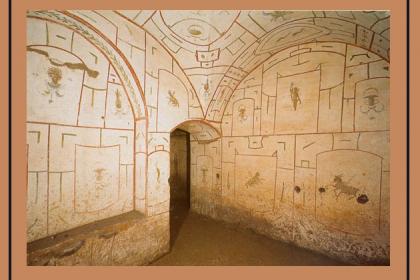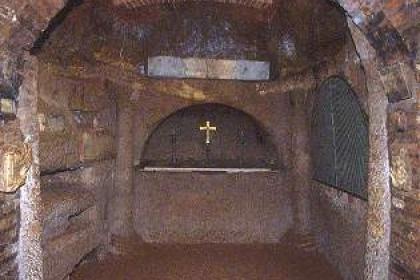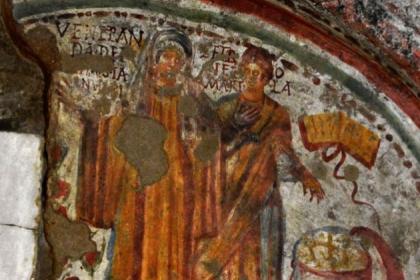
40 thousand burials in 13 kilometer long tunnels, including simple common loculi and frescoed cubicles, with an unusually high number of popes and martyrs that earned it the nickname Regina Catacumbarum, the queen of the catacombs. As recounts the Depositio Martyrum, a fourth-century Christian text, here rested Pope Marcellinus and Pope Marcellus, killed during Diocletian’s persecutions, the martyrs Felix and Philip, Pudenziana and Praxedes, Maurus and Simetrius, along with 360 other anonymous martyrs and Pope Sylvester, to whom the basilica built above the catacombs in the 4th century was dedicated.
Located in the section of the Via Salaria that runs alongside the park of Villa Ada Savoia, in whose bowels it partially runs, it is one of the largest, most important and ancient cemeteries in the city. The catacomb was excavated in the tufa between the 2nd and 5th centuries, partly reusing pre-existing underground structures, including a pozzolan quarry (the Arenarium) and the hypogeum with the tombs of the Acili Glabrioni. Priscilla, the noblewoman after whom the catacomb is named and who possibly donated the land, belonged most probably to this Roman senatorial family.
In the 16th century, when it was rediscovered after being forgotten for centuries, it was robbed of tombstones, sarcophagi and relics. Nevertheless, it still preserves particularly beautiful and significant paintings. In the vault of a gallery in the Arenarium, next to a stucco of the Good Shepherd, we can see the oldest depiction of the Virgin Mary and the Child (late 2nd-early 3rd century), with the prophet Balaam next to her pointing to a star. Also in the central Arenarium is the cubiculum of the veiled woman. The room takes its name from the painting in the back “lunetta”, which depicts a young woman in rich liturgical dress with a veil on her head: on the sides of the woman are represented two unique scenes in cemetery painting, probably episodes from her life, her marriage, motherhood, and faith.
Pompeian-style paintings and stuccoes of great formal refinement also decorate the so-called “Greek Chapel”, taking its name from two Greek inscriptions painted here, first seen by the discoverers. Datable to the advanced 3rd century, the room has a distinctive shape with three niches for sarcophagi and a counter for the ritual banquets that took place near the tombs in memory of the dead. One of the paintings depicts a banquet, which however has a clear reference to the Eucharistic banquet: at a semicircular triclinium, where bread and fish are served, are seated seven figures including a young man breaking bread and a veiled woman. There are also numerous episodes taken from the Old and New Testament, for example, Moses making water flow from the rock; the sacrifice of Isaac; the resurrection of Lazarus; and the adoration of the Magi.
Inside Villa Ada is the Basilica erected by Pope St. Sylvester and dedicated to him, which fell into disrepair and was rebuilt in the late 19th century using original remains and structures. A museum has been set up in a room adjacent to the basilica, collecting hundreds of sarcophagus fragments found during excavations in the area.
The Catacombs of San Sebastiano

 Condividi
Condividi
Catacombs of Saint Agnese

 Condividi
Condividi
Catacombs of Domitilla

 Condividi
Condividi
Information
For the opening times and guidelines please check the official website
 Condividi
Condividi
Location
To find out about all accessibility services, visit the Rome accessible section.











































